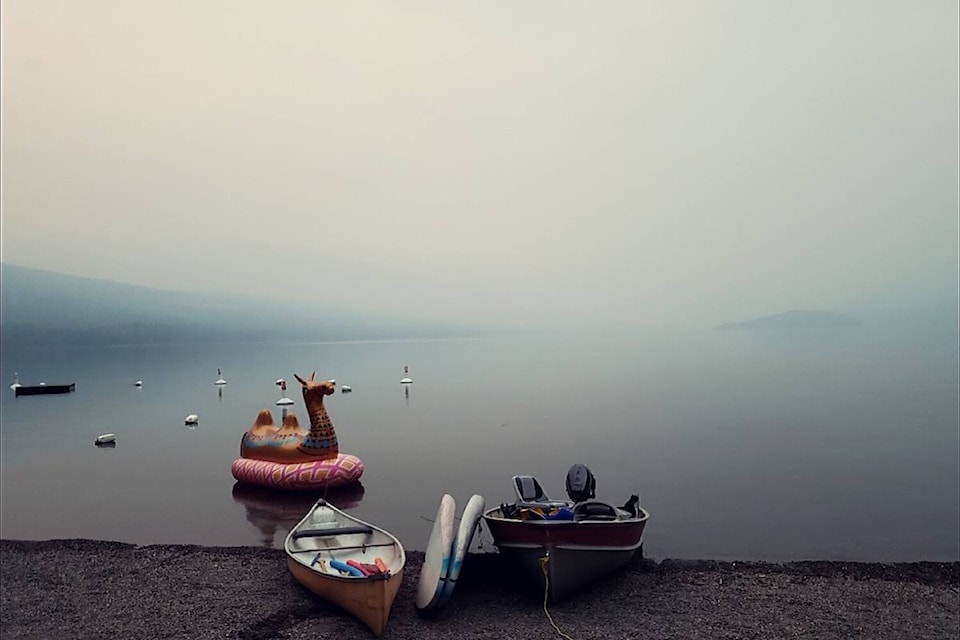Smoke advisories loomed over the Okanagan for most of August last year; now dust advisories have been dominating most of this year’s winter and spring.
Though there’s nothing locals can do to prevent poor air quality outside, human rights lawyer and mother of two, Kelsey Robertson began asking the question: what can we do?
“I became interested in the wildfire smoke because I have two young children and in August last year, it sucked. I think there was about three weeks straight where there were air quality advisories so we couldn’t go outside, and that’s when I became concerned and started phoning people to try to find out more.”
Soon though, her concern turned to frustration.
Her first calls were to the City of Vernon, who directed her to phone Interior Health, who said there was nothing they could do without recommendations by the municipalities.
“It was sort of a cyclical thing where they all seemed to be relying on someone else to have be able to supply information and solutions, so it ended up being unresolved, which was interesting from my perspective.”
Related: Air quality improves slightly
Related: Okanagan air quality to deteriorate again
From there, she joined the sustainable environment network society (SENS) and began learning about the various issues associated with poor air quality — everything from physical side effects to mental health.
One of the main issues she came to learn were the detrimental health effects — specifically for children — caused by wildfire smoke. Research has shown that smoke and smog affect even the healthiest children much more than adults because their respiratory system — nose, throat and lungs — is still developing. Scientists have determined that the poor air children breathe can cause health problems for many years.
Since starting to make calls last summer, Robertson has made strides in the community and become somewhat of an advocate for change within the city.
“I think it’s a matter of what can we do today and then what can we do to plan for the future,” she said. “Getting high-efficiency particulate air (HEPA) filters and having PurpleAir monitors stations around the city is key today. Then in terms of the future, it’s all about policy planning. We’re looking right now at getting a recreation centre and, though it’s not completely set in stone, it’s part of our long-term plan.”
A HEPA filter is a type of mechanical air filter that works by forcing air through a fine mesh that traps harmful particles such as pollen, pet dander, dust mites, and tobacco smoke. PurpleAir monitors are a proven air quality monitoring solution. Robertson is hoping to attract people to buy these monitors because, once installed and registered online, it will allow people to compare air quality throughout the city — where quality is particularly bad and where it is safe to be outside.
Related: No end in sight, smoke is here to stay
While another indoor facility is her long-term goal, she is hoping to gain momentum for what can be done today: opening up public places and extending their hours when advisories are in effect. She spoke about one particularly bad Sunday last year when the recreation centre was packed, and the mall, which had recently had its front doors driven through, was full of smoke, and the public library was closed.
“There was really nowhere to go which is a problem, especially when you have kids,” she said.
“We need indoor facilities that you can take your kids to when there’s these air advisories or with climate change, there are colder days in the winter where it’s unbearable to be outside. We just need to adapt to the environment and that’s natural adaptation that the Okanagan needs to have.”
She said that currently, if there was a state of emergency, the only place in the city that people could go for clean air would be the hospital.
“In terms of just general emergency planning, I think that’s a failure.”
But, since last August, she said there have been some successes. For instance, worried that the smoke advisories could potentially continue into September, she began advocating for HEPA filters to be placed in schools. Though the school board is awaiting the city’s assessment, Robertson said they are seriously considering the technology. She considers it a “win” because of the detrimental effects on children, but still hopes schools will also begin using PurpleAir monitors so they can determine whether it’s safe for kids to play outside at reccess.
“There’s really critical information about health and I don’t think the Ministry of Environment is really putting that out there, but I think people need to know and we need to start making changes,” she said. “It’s just about adaptation for the future.”
Related: Dust advisory over for Vernon
Related: Vernon dust advisory continued again
To report a typo, email:
newstips@vernonmorningstar.com.
Follow me on Twitter @BrieChar
Email me brieanna.charlebois@vernonmorningstar.com
Like us on Facebook.
